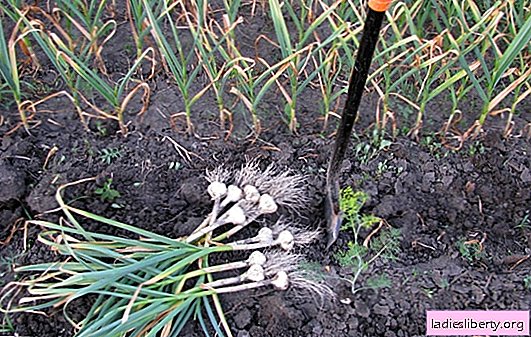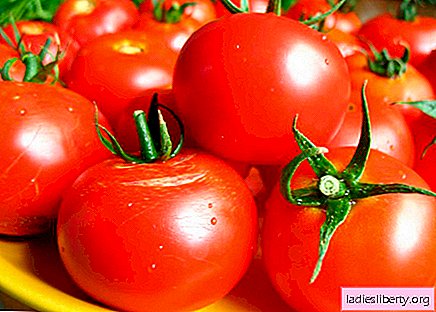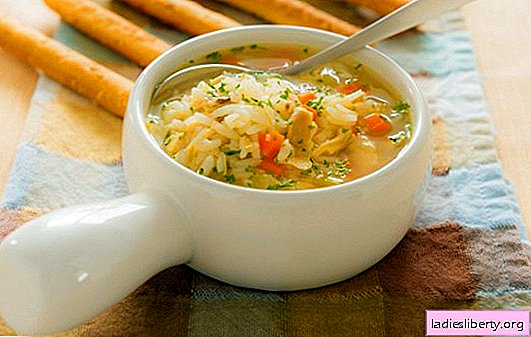
In addition to the general rules, the care, planting and cultivation of garlic has its own characteristics for winter and spring species. For the full development of the plant and the preservation of the harvest it is also necessary to ensure the fight against diseases and pests.
General rules for growing garlic: types and methods of reproduction
Growing garlic has some nuances for the following types:
- winter. Gives an arrow very resistant to frost. Planting it is carried out in the fall, it winters, and in the next season a full-fledged big head grows;
- spring. Do not give arrows. Planting - in the spring, he is able to store more rows, but his harvest is not so high.
Methods of reproduction, selection of teeth and seeds
Garlic propagates vegetatively, the arrowed species multiplies also by seeds.
For planting, only the cloves of the bulbs are taken from the spring species, winter can be propagated with teeth and seeds from aerial onions. But in the latter case, you must wait 2 years for the harvest of full-fledged bulbs.
In the first year, the bulb will give a small onion sets from one clove. It has the same beneficial qualities as regular garlic. The next year will grow a normal onion with a lot of cloves.
Gardeners often prefer the arrow garlic: it gives a good harvest.

shooter winter garlic
Reproduction is mainly carried out by teeth: the harvest of full-fledged bulbs is harvested in the year of planting. Every gardener knows how important it is to select the best, healthy seed. Also recommend periodically updating varieties. When selecting heads, it does not matter the form - spring or winter - they choose the healthiest and most qualitative in shape, weight of teeth.
Necessary actions before planting:
- sorting material by size and appearance. Remove small, infected with diseases, with bottoms in cracks, irregular in shape, with two vershinkami, shrunken, twin garlic;
- remove dry, flabby, with any diseases teeth;
- do not recommend planting garlic from plants that have a stem nematode and other diseases;
- leave intact, large, with a whole shell of garlic;
- the selected material is to be disinfected with ash solution: 400 g of ash per 200 g of water. The mixture is boiled for half an hour, then cooled, drained. Cloves soak in it for 2 hours. If there is a suspicion of infection by a fungus, the heads are kept in a formalin solution, and then dried.
The planting and cultivation of spring varieties of garlic is also carried out. germinated material: it will accelerate the growth of the plant.
Necessary conditions for germination: teeth wound with a damp cloth, placed in a bag of polyethylene, kept for 3 days, at room temperature. If grown with seeds from arrows, then choose healthy arrows with large baskets and dry them. They use the largest and most mature ones - small ones are also planted, but they will not give high-quality planting material.
Growing garlic: soil, beds, crop rotation
Proper garlic cultivation includes soil care and fertilizer. If it is poor, additionally complex fertilizer or superphosphates with potassium chloride (proportion 4: 1) is introduced into it. Ordinary manure added to the land in the fall will increase the yield. He will need 5 kg per 1 square. m., if the soil is very poor, you can increase this rate. But do not abuse this: garlic does not like too much fertilized soil. The ground should be light, sandy or loamy.
Growing garlic will give good results if you create the necessary conditions, including a fairly fertile soil, fertilizing, watering. Sandy or loamy fertile soils that garlic loves should be cultivated and with acidity indicator closer to neutral. An excessively moistened substrate, especially at a time when the ground is drawing moisture from the melt water in the spring, is detrimental to the development of the plant. In this case, the winter varieties will get wet, and the spring varieties will become impossible to plant on time.
Depending on the planted species choose different depth, width of rows, spacing. General care and necessary conditions in all cases:
- carefully leveled earth, dressing mulching of beds after disembarkation. For this purpose, humus is used, less often - peat. On 1 square. m. will be enough 10 liters, that is, a bucket.
- landing is done in the beds with wide aisles. Place for them: sunny, well lit.

garlic bed
Below are the necessary conditions regarding the neighborhood of other plants and the seed shift. The main thing is not to plant garlic in the beds where before that he and onions. After them, you have to wait 4 years to update the soil. The same applies to potatoes. After beets, cucumbers, cabbage, any legumes, pumpkin garlic will give the best yield. The soil after them, as a rule, is optimally fertilized with organic matter, its care is simpler, the possibility of disease damage decreases. But it is not recommended to share only the beds with them: they inhibit the development and growth of garlic.
The best fit for the light-garlic - in separate unbroken beds. If the places are few, they organize rows adjacent to vegetables, and berries. Neighborhood allowed with carrots, cucumbers, potatoes, black currants, gooseberries, strawberries, raspberries. Neighborhood with gladioli, tulips, roses will benefit. Care of the latter will be easier: garlic protects them from black spot.
Growing garlic spring varieties
For spring varieties, spring planting is relevant.
The necessary conditions:
- landing after the snow melted (April - May);
- temperature mode of landing from + 5 ° C and above. At this time, the soil is usually wet, so watering is not needed. If the soil is dry it will be necessary to moisten the soil abundantly.
- Spring variety is planted at a depth of double height of a clove (3-5 cm). If the clove was germinated, it should be planted carefully so as not to harm the roots. Next, immediately mulch the beds. Planting and cultivation of garlic is not particularly difficult. Rows are made with a gap of 18-20 cm, garlic placed in 7-9 cm
Garlic grows at + 3 ° C and above, it is not afraid of frost.
Necessary conditions for better development at different stages:
- the beginning of the growing season: + 5 ... + 10 ° C;
- nucleation, onion formation: + 15… + 20 ° C;
- development and maturation: + 20 ... + 25 ° C.
For a good harvest, mulching of the beds is mandatory, especially if the crop grows in a region with hot summers. Mulch is recommended light (from straw, hay).

planting garlic cloves
Planting garlic winter varieties
Growing garlic winter varieties has its own characteristics. Necessary conditions for this:
- landing time: September October. Timeliness is important: early will cause growth ahead of time, which will reduce frost resistance; later - the cloves will not have the strength to root well, frost will prevent this;
- the soil should settle, so the plot is prepared a week before disembarking. Further, furrows are created, a layer of coarse sand or ash of 1.5–3 cm is poured at their bottom, so seedlings will not come into contact with the soil and will rot;
- gap between the rows - 20-25 cm, garlic planted in 8-10 cm or 12-15, if they are very large. For winter crops, a deeper planting is desirable - 8 cm with loose soil.
- care includes mulching beds: it additionally protects against cold. Enough 1.5-2 centimeters layer of mulch. It is made from dry peat, a mixture of sawdust with the ground. In case of severe frosts and small snow cover, the beds are covered with polyethylene, and roofing material is suitable. But they need to be removed immediately when the snow begins to fall so that it covers the ground. Instead of these materials, you can use a thicker layer of mulch.
At the same time, seeds are planted from bulbous bulbs at a depth of 2 centimeters, according to the 2 x 10 cm planting scheme. Sow also in early spring - by mid-April. The harvest of one-teeth obtained from the arrows, pulled out of the ground, dried, planted again - the next year they give full-fledged bulbs. Winter garlic is resistant to cold. Rooted garlic tolerate winter and frost temperatures as low as -20 ° C. But if there is not enough snow, too low temperature can lead to freezing, so be sure to mulch the beds, throw snow on them and cover.
In the warm season, the same care is needed for winter varieties as for the spring ones: the temperature regime, watering, fertilizing, and mulch are the same during the summer months.
Flower arrows from the corresponding winter species are removed when they reach 10 cm, thanks to which the harvest is more generous. Plants with arrows leave if bulb bulbs are needed for seeds.
Growing garlic: care, watering, feeding
Garlic cultivation and care consists of the following items: mulching, watering, loosening, dressing, weeding.
Watering garlic should not be too abundant. The standard is watering 10 liters per square meter, if the soil is very dry. The interval is a week. As water ripens, less is required (8-6 liters) so that the bulbs do not rot. Two weeks before harvesting, watering is stopped. Watering can be characterized by the following rule: excessive moisture damages garlic, but it requires systematic soil moisture, especially in the early growing season.
After each wetting soil gently loosened 2-3 cm. If there is mulch, this is not required. The arrows are removed when they reach 5-8 cm - the harvest will be more generous. The first feeding is done after 2-3 leaflets have formed: a large spoon of urea is diluted in a bucket of water. On 1 sq. M. 5 l will be enough. The following feeding is in two weeks: a teaspoonful of urea is enough for a bucket of water, one large spoonful of double superphosphate, potassium sulfate. The third (last) top dressing is at the end of June, when garlic forms are formed, onions are formed and arrows appear. On a bucket of water enough 2 large spoons of double superphosphate and one - potassium sulfate.
Top dressing combined with watering. In the period between fertilizers, plants are sprinkled with wood ash: one cup per 1 square meter. If there is mulch, loosening is not required. The best mulch for garlic from straw. The bed is covered with it when the shoots reach 10-15 cm. It does not allow moisture to evaporate - watering can be done less often.
Feeding is also carried out according to the following scheme:
- the first: in the spring after the snow melt. Solutions for this are well suited: manure (cow) (1:10) or bird droppings (1:12);
- the second: June - July. The solution is made from ash: 200 g per 10 l of water.
Weeding spend systematically with the emergence of weeds. Watering for winter varieties should be more abundant. In winter, the beds are covered with snow.
Watering rules:
- the first phase (active growth) is abundant;
- the second phase (the maturation of the bulbs) - moderate;
- during the rainy period, watering is stopped altogether.
High humidity in the second half of the growing season may cause diseases and bulging of the bulbs.
Garlic Cultivation: Tricks and Tips
Garlic from the head to unpin at the time of the landing. Recommend to choose the most extreme segments: the harvest is more generous. Planting is carried out not by pressing into the soil, but by placing it in an excavated recess.
As soon as the shoots are shown, the soil is loosened, but only 1-2 cm deep, then the bed is mulched, and fertilizing is done with mullein or urea. If the soil of the garden is dry, it should be watered, otherwise the garlic will be dry and bitter.
Growing spring varieties of garlic does not require a deep planting - 2-3 cm is enough, for winter crops - 8 cm. The crop is harvested as soon as the leaves start to wither.
Growing garlic: pests and diseases
Growing garlic is often accompanied by diseases:
- gelmintospirosis. The reason is a fungus. Brown depressed spots on teeth. Over time, the spots become black, the fabric of the teeth rot. Planting is not done by such teeth: chlorotic stains will appear on the plants, they will be sluggish, the leaves will die. Often affects garlic with white scales. Infection occurs through poor-quality material, so it is etched with formalin - 2-3 ml per half liter of water is enough. Teeth immersed in it for 10 minutes in the pouch. Pull out, wrapped in cloth for 2 hours, then dried and aired. Garlic can become infected with this disease on a bed from bulbous or solanaceous (potatoes, tomatoes);
- neck rot. Appears with other diseases. Particularly develops with inadequate storage and transportation, as well as on non-mature and wet heads. Infection can occur from diseased planting material or from the soil. Treatment: formalin disinfection of the storage site, sorting and removal of diseased material;
- Donets rot - Fusarium. The reason is a fungus. Symptoms: yellow leaves, dying off of the roots, patches of mycelium (mycelium) on the bottom of a white, pink shade, it is he who causes rotting of the bulb. Good results of treatment are given by the Quadris fungicide, also use against fungi;
- bacterial rot. Pathogens - bacteria. Symptoms: brown sores on garlic, they become vitreous, the color changes, there is a smell of rot. Treatment: before planting, pickle in blue vitriol, in fungicide, for example, in "Fundazole";
- powdery mildew - peronospirosis. Symptoms: a gray tint on the leaves, arrows, dried diseased parts of the plant, unripe bulbs. Means: treatment with fungicide "Thiram", fentiuram. Spraying with fungicides (“Arceride”, polycarbicide);
- white rot. The reason is a fungus. Symptoms: yellowing, dying off of the leaves, white mycelium on the roots, bulbs. Means: dressing before planting with "Tiram", foundation, means against fungi;
- green mold - penicillus. Means: soil disinfection with copper-containing fungicides, planting material care and dressing with formalin;
- Black mold - Stemfiliosis. Symptoms: yellow spots on the leaves, which gradually become covered with black mold. It is not fatal, but reduces the yield. Means such as against other fungal ailments;
- stem nematode. Treatment: etching in a solution of potassium permanganate and formalin.

fusarium
Folk remedies to combat diseases of garlic:
- against powdery mildew. Ash solution: 200 g per 10 l, aged for 5 days. Mullein infusion: 1 kg per 10 liters of water, you need to insist day. For spraying is also used a decoction of horsetail;
- against fungal diseases. Infusion of marigolds upright: 500 g is poured over 10 liters of hot water, for 12 hours.
Of the pests are the most dangerous onion flies, their larvae, they feed on the bulbs. Dangerous onion hoaxers, thrips, covertmoths, moths, stem nematodes, as well as ticks: root and garlic are dangerous. Means of struggle: insecticides "Rogor" or "Keltan", etching with colloidal sulfur.
Protect garlic planted near chicory, calendula.
Prevention and necessary conditions to exclude diseases:
- planting and growing garlic from healthy seeds only, which are systematically checked and sorted during storage;
- dressing if necessary;
- airing, cleaning, removal of organic residues from storage;
- proper care, crop rotation and crop change;
- well lit beds.











